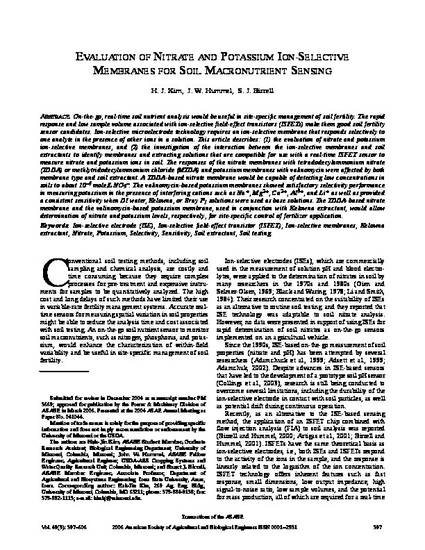
A real-time soil nutrient sensor would allow efficient collection of data with a fine spatial resolution to accurately characterize within-field variability for site-specific nutrient application. Ion-selective electrodes are promising candidates because they have rapid response, directly measure the analyte, and are small and portable. Our goal was to investigate the ability of three different phosphate ion-selective electrodes (two fabricated with organotin compound-based PVC membranes, and one fabricated from a cobalt rod) used in conjunction with Kelowna soil extractant to determine phosphorus over the typical range of soil concentrations. Electrodes using organotin compound-based PVC membranes containing bis(p-chlorobenzyl)tin dichloride as an ionophore exhibited sensitive responses to HPO42- over a range of 10-4 to 10-1 mol/L in Tris buffer at pH 7. They were nearly insensitive to phosphate when using Kelowna soil extractant as the base solution, perhaps because of the high concentration of fluoride (0.015 mol/L) in the Kelowna solution. In addition, the life of the membranes was less than 14 days. Electrodes using another tin-compound-based PVC membrane containing tributyltin chloride as an ionophore also provided unsatisfactory results, showing much less sensitivity to H2PO4- than previously reported. The cobalt rod-based electrodes exhibited sensitive responses to H2PO4- over a range from 10-5 to 10-1 mol/L total phosphate concentration with a detection limit of 10-5 mol/L in the Kelowna solution. This detection range would encompass the typical range of soil phosphorus concentrations measured in agricultural fields. The selectivity of the cobalt electrodes was satisfactory for measuring phosphates in the presence of each of six interfering ions, i.e., HCO3-, Cl -, Br -, NO3-, Ac -, and F -, with the electrodes being 47 to 1072 times more responsive to phosphate than to the tested interfering ions.
Available at: http://works.bepress.com/stuart_birrell/11/

This article is from Transactions of the ASABE 50 (2007): 415–425, doi:10.13031/2013.22633.